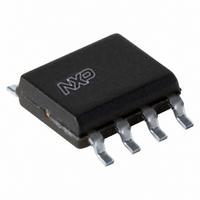AU5790D/N,118 NXP Semiconductors, AU5790D/N,118 Datasheet - Page 5

AU5790D/N,118
Manufacturer Part Number
AU5790D/N,118
Description
IC CAN TXRX SINGLE WIRE 8SOIC
Manufacturer
NXP Semiconductors
Series
AUr
Type
Transceiverr
Datasheet
1.AU5790D112.pdf
(20 pages)
Specifications of AU5790D/N,118
Number Of Drivers/receivers
1/1
Protocol
CAN
Voltage - Supply
5.3 V ~ 27 V
Mounting Type
Surface Mount
Package / Case
8-SOIC (3.9mm Width)
Lead Free Status / RoHS Status
Lead free / RoHS Compliant
Other names
935277457118
AU5790D/N-T
AU5790D/N-T
AU5790D/N-T
AU5790D/N-T
Available stocks
Company
Part Number
Manufacturer
Quantity
Price
Part Number:
AU5790D/N,118
Manufacturer:
NXP/恩智浦
Quantity:
20 000
1. RxD outputs the bus state. If the bus level is below the receiver threshold (i.e., all transmitters passive), then RxD will be floating (i.e., high,
Philips Semiconductors
FUNCTIONAL DESCRIPTION
The AU5790 is an integrated line transceiver IC that interfaces a
CAN protocol controller to the vehicle’s multiplexed bus line. It is
primarily intended for automotive “Class B” multiplexing applications
in passenger cars using a single wire bus line with ground return.
The achievable bit rate is primarily a function of the network time
constant and the bit timing parameters. For example, the maximum
bus speed is 33 kpbs with bus loading as specified in J2411 for a full
32 node bus, while 41.6 kbps at is possible with modified bus
loading. The AU5790 also supports low-power sleep mode to help
meet ignition-off current draw requirements.
The protocol controller feeds the transmit data stream to the
transceiver’s TxD input. The AU5790 transceiver converts the TxD
data input to a bus signal with controlled slew rate and waveshaping
to minimize emissions. The bus output signal is transmitted via the
CANH in/output, connected to the physical bus line. If TxD is low,
then a typical voltage of 4 V is output at the CANH pin. If TxD is high
then the CANH output is pulled passive low via the local bus load
resistance R
module ground, the resistor R
AU5790. By providing this switched ground pin, no current can flow
from the floating module ground to the bus. The bus receiver detects
the data stream on the bus line. The data signal is output at the RxD
pin being connected to a CAN controller. The AU5790 provides
appropriate filtering to ensure low susceptibility against
electromagnetic interference. Further enhancement is possible with
applying an external capacitor between CANH and ground potential.
The device features low bus output leakage current at power supply
failure situations.
If the NSTB and EN control inputs are pulled low or floating, the
AU5790 enters a low-power or “sleep” mode. This mode is
dedicated to minimizing ignition-off current drain, to enhance system
efficiency. In sleep mode, the bus transmit function is disabled, e.g.
the CANH output is inactive even when TxD is pulled low. An
internal network active detector monitors the bus for any occurrence
Table 1. Control Input Summary
NOTE:
2001 May 18
Single wire CAN transceiver
considering external pull-up resistance). Otherwise, if the bus level is above the receiver threshold (i.e., at least one transmitter is active),
then RxD will be low.
NSTB
0
0
1
1
T
. To provide protection against a disconnection of the
EN
0
1
0
1
Don’t Care
Tx-data
Tx-data
Tx-data
T
is connected to the RTH pin of the
TxD
Sleep mode
Wake-up transmission mode
High-speed transmission mode
Normal transmission mode
Description
5
of signal edges on the bus line. If such edges are detected, this will
be signalled to the CAN controller via the RxD output. Normal
transmission mode will be entered again upon a high level being
applied to the NSTB and EN control inputs. These signals are
typically being provided by a controller device.
Sleeping bus nodes will generally ignore normal communication on
the bus. They should be activated using the dedicated wake-up
mode. When NSTB is low and EN is high the AU5790 enters
wake-up mode i.e. it sends data with an increased signal level. This
will result in an activation of other bus nodes being attached to the
network.
The AU5790 also provides a high-speed transmission mode
supporting bit rates up to 100 kbps. If the NSTB input is pulled high
and the EN input is low, then the internal waveshaping function is
disabled, i.e. the bus driver is turned on and off as fast as possible
to support high-speed transmission of data. Consequently, the EMC
performance is degraded in this mode compared to the normal
transmission mode. In high-speed transmission mode the AU5790
supports the same bus signal level as specified for the CANH output
in normal mode.
The AU5790 features special robustness at its BAT and CANH pins.
Hence the device is well suited for applications in the automotive
environment. The BAT input is protected against 40 V load dump
and jump start condition. The CANH output is protected against
wiring fault conditions, e.g., short circuit to ground or battery voltage,
as well as typical automotive transients. In addition, an
over-temperature shutdown function with hysteresis is incorporated
protecting the device under system fault conditions. In case of the
chip temperature reaching the trip point, the AU5790 will latch-off
the transmit function. The transmit function is available again after a
small decrease of the chip temperature. The AU5790 contains a
power-on reset circuit. For V
be turned off, the output will be passive, and RxD will be high. For
2.5 V < V
be turned off.
bat
< 5.3 V, the CANH output drive may operate normally or
0 V
0 V, 12 V
0 V, 4 V
0 V, 4 V
bat
< 2.5 V, the CANH output drive will
CANH
float (high)
bus state
bus state
bus state
AU5790
RxD
Product data
1
1
1
















